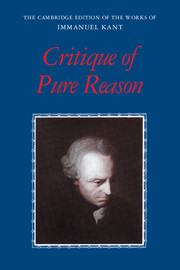Book contents
- Frontmatter
- Contents
- General editors' preface
- Acknowledgments
- Introduction
- Immanuel Kant, Critique of Pure Reason
- I Transcendental doctrine of elements
- Division one. Transcendental analytic
- Book I Analytic of concepts
- Book II Analytic of principles
- Chapter I On the schematism of pure concepts of the understanding
- Chapter II System of all principles of pure understanding
- Chapter III On the ground of the distinction of all objects in general into phenomena and noumena (as in the first edition)
- Chapter III On the ground of the distinction of all objects in general into phenomena and noumena (as in the second edition)
- Appendix: On the amphiboly of concepts of reflection
- Remark to the amphiboly of concepts of reflection
- Division two. Transcendental dialectic
- II Transcendental doctrine of method
- Editorial Notes
- Glossary
- Index
Chapter I - On the schematism of pure concepts of the understanding
from Book II - Analytic of principles
Published online by Cambridge University Press: 05 July 2013
- Frontmatter
- Contents
- General editors' preface
- Acknowledgments
- Introduction
- Immanuel Kant, Critique of Pure Reason
- I Transcendental doctrine of elements
- Division one. Transcendental analytic
- Book I Analytic of concepts
- Book II Analytic of principles
- Chapter I On the schematism of pure concepts of the understanding
- Chapter II System of all principles of pure understanding
- Chapter III On the ground of the distinction of all objects in general into phenomena and noumena (as in the first edition)
- Chapter III On the ground of the distinction of all objects in general into phenomena and noumena (as in the second edition)
- Appendix: On the amphiboly of concepts of reflection
- Remark to the amphiboly of concepts of reflection
- Division two. Transcendental dialectic
- II Transcendental doctrine of method
- Editorial Notes
- Glossary
- Index
Summary
In all subsumptions of an object under a concept the representations of the former must be homogeneous with the latter, i.e., the concept must contain that which is represented in the object that is to be subsumed under it, for that is just what is meant by the expression “an object is contained under a concept.” Thus the empirical concept of a plate has homogeneity with the pure geometrical concept of a circle, for the roundness that is thought in the former can be intuited in the latter.
Now pure concepts of the understanding, however, in comparison with empirical (indeed in general sensible) intuitions, are entirely un-homogeneous, and can never be encountered in any intuition. Now how is the subsumption of the latter under the former, thus the application of the category to appearances possible, since no one would say that the category, e.g., causality, could also be intuited through the senses and is contained in the appearance? This question, so natural and important, is really the cause which makes a transcendental doctrine of the power of judgment necessary, in order, namely, to show the possibility of applying pure concepts of the understanding to appearances in general. In all other sciences, where the concepts through which the object is thought in general are not so different and heterogeneous from those that represent it in concreto, as it is given, it is unnecessary to offer a special discussion of the application of the former to the latter.
- Type
- Chapter
- Information
- Critique of Pure Reason , pp. 271 - 277Publisher: Cambridge University PressPrint publication year: 1998



